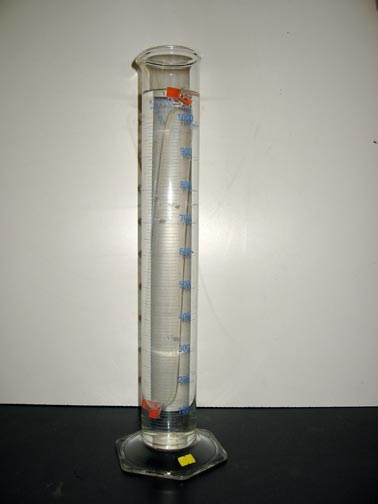The properties of semipermeable membranes
 The ability of ions to pass through a membrane composed of dialysis tubing is demonstrated.
The ability of ions to pass through a membrane composed of dialysis tubing is demonstrated.
Ingredients: dialysis membrane, sodium chloride, silver nitrate
Procedure: A complete recipe follows.
1. Fill a 30 centimeter dialysis tube with concentrated sodium chloride solution.
2. Seal the tube.
3. Immerse the "sausage" in a graduated cylinder so as to surround with water.
4. After 10 minutes, remove the "sausage" from the solution.
5. Add 20 mL of saturated silver nitrate solution to the cylinder.
6. Observe the reaction.
Understanding: The presence of chloride ion in solution can be detected by the addition of silver nitrate solution. The silver cation will combine with the chloride anion to form a white precipitate of insoluble silver chloride.
Ag+(aq) + Cl-(aq) → AgCl(s)
An initial test of the water in the graduated cylinder demonstrates the absence of chloride ion in the solution. Following the addition of the "sausage" containing sodium chloride solution to the cylinder, the addition of silver nitrate to the graduated cylinder produces a "cheese-like" white precipitate. The formation of the precipitate demonstrates the presence of chloride ion in the solution. How did they get there? The chloride ions passed through the semipermeable membrane of the dialysis tubing.The chloride ions are initially at a high concentration within the "sausage." The ions move randomly about by the process of diffusion. The difference in concentration of chloride ion within and without the "sausage" creates osmotic pressure. Water enters the dialysis tubing to lower the concentration of chloride ions within the "sausage," and chloride ions flow out of the tube to increase the concentration of chloride ions outside the "sausage." The process continues until the concentration of chloride ion within and without the "sausage" is equal.
Osmotic pressure and ion selective membranes
Question: Suppose the same experiment was carried out with a membrane that is permeable to chloride ions but not to sodium ions. Would we observe a precipitate of silver chloride?You can check your answers here.